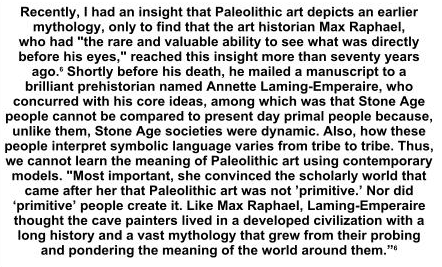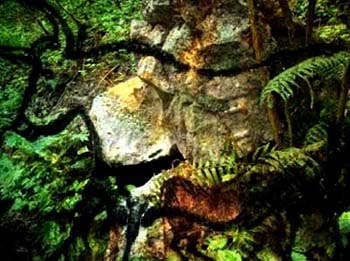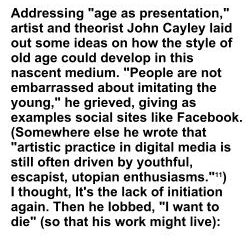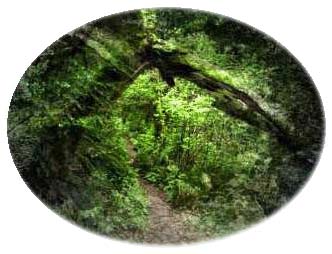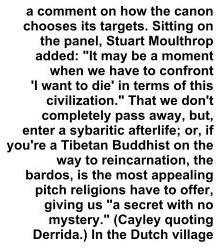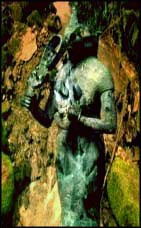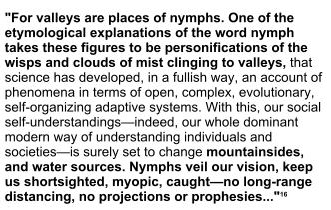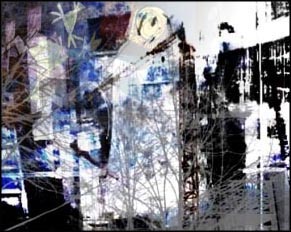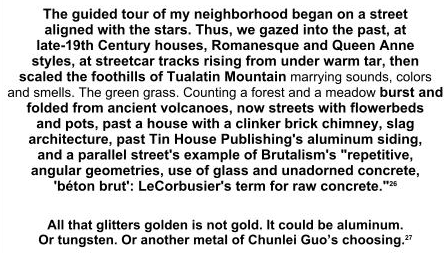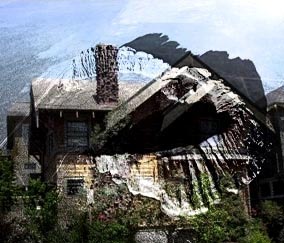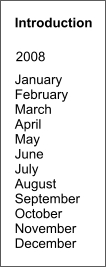
|
|
June 8. While Matsuo Bashō sat at home by his banana tree, he dreamed of his next journey. His most memorable writing is about his first steps into the unknown. For example, from "Journal of Bleached Bones in a Field": “I set out on a journey of a thousand leagues, packing no provisions. I leaned on the staff of an ancient who, it is said, entered into nothingness under the midnight moon.”4 There is a wide avenue between traveling in 17th Century Japan and in the 21st Century. The adventure now is in wondering if your flight will take-off on schedule, whether your luggage will arrive in same place you do, or if the highway will be jammed with traffic. It is also different from the fantasy of Tibet, where “Lokesh always traveled, not in a straight line but from flower to flower, or rock to rock, stopping to examine the shapes of nature in whatever form might capture his curiosity."5 This overcast morning, I choose an entrance into the forest from which people and dogs were emerging. I walk quickly away from this on a narrow trail.
"It's an obstacle course up ahead," one of the trail crew warns me. Unlike mountain goats, for us, walking on incoherent ground, surefootedness not to be taken for granted. I make it through without falling+, all mud and bravado.
9. Coffee this morning with Brother Christian, Prior of Christ in the Desert Monastery, here this visit his mother, who is a neighbor of mine. Christ in the Desert is a Benedictine Abbey near Abiquiú NM, "fifteen miles up the Chama River, deep in the Chama wilderness and hard alongside the enormous cliff-walled bulk of Mesa de los Viejos, the Mesa of the Ancients."8 Founded in 1964, designed by the Japanese architect George Nakashima, I stayed there for a few days in the early 1980s, while doing research for my annotation of Thomas Merton's Woods, Shore, Desert.8 Merton had visited the monastery twice in 1968, the year of his death.+ My first day at the monastery I was welcomed by an ant who bit my foot, a painful swelling of love. I hobbled around in silence broken only by an occasional friendly nod.
Br. Christian, a man in his mid-50s, was living there, but I have no recollection of meeting him. Now we sit in a Starbuck's exchanging stories. He caught me up on how the monastery has since developed, and then we spoke of Thomas Merton.
11. I've
been avoiding discussing the Electronic Literature Organization's "Visionary
Landscapes" conference, held almost two weeks ago at Washington
State University, Vancouver, maybe from of the memory of missing the
first day because of food poisoning the night before. But on the phone
this morning, Kevin Campbell, who attended the conference with me, began
discussing it, saying that he found a humanity in the presentations
that he hasn't yet found on the Internet, which made me think of the
awkwardness of young academics who seemed to swallow their words, as
if they were not ready to nourish the conversation, as opposed to the
older, more seasoned, presenters.
of Zundert, where Vincent van Gogh was born, is the gravestone of his namesake brother who was stillborn exactly one year before the painter arrived. So, all through his childhood, Vincent saw his name on a gravestone. It was as if he was twice-born and already once dead. "When he revisited this cemetery in 1877, at the age of 24, Vincent described the sunrise he witnessed there as 'reminiscent of the Resurrection.'"12 After his brother's death, Vincent's mother was unable to give him the love a child needs. "In simple terms, death became synonymous with being loved and cherished, while being alive was identified with rejection."12
12. Back to the ELO conference. My notes are out of order, but which talk was given on which day in which order doesn't matter now: the printed schedule is a souvenir. Saturday morning we joined an evocative discussion on practical problems facing archivists of "born-digital materials," along with philosophical ones, such as "the presumption of authenticity." To many artists who primarily work on the web, the question of their contributions being ushered through the maze of hardware and software not yet invented is a problem. However, all art has similar hurtles to negotiate. Paintings deteriorate, disappear into private collections, or are destroyed in various ways, including earthquakes and wars. While the art becomes more valuable after the artist dies, some works that never existed have gained existence when the collection that allegedly included them disappeared. The ghost of disappearance reveals the illusion of depth.
As I began writing decades before the event of the personal computer, I have two archives: one paper the other digital, hosted by universities thousands of miles apart. The paper one, stored in boxes, must be read on-site. The electronic one can be accessed from anywhere in the world. Paper is irreplaceable, the markings on it have singular authenticity; while digital work, constructed of zeros and ones, can easily be cloned. With a painting, or the manuscript of a book, what a masterpiece is depends on how much collectors are willing to pay, which, in turn, depends on its critical celebrity. In the digital world, a masterpiece, having no physical provenance, finds value in the technique of its construction and the depth of its resolution. On Sunday morning, I had breakfast with Brian Evans, a musicologist at the University of Alabama who now teaches art. Before the conversation segued to Paleolithic art, Evans telling me how the Golden Section was used 40,000 years ago for the harmony of its proportions. we discussed the problem of archiving digital work from the historical standpoint of early electronic music. Although for centuries oil paint was basically the same, even in the near future we cannot know what form digital art will take, as technologies evolve. Thus, the art and the software it was made to run on must be saved together. On the first panel, Carolyn Guertin of the University of Texas described digital novels as not being literature but a new model of "social aesthetics." Wherever materiality has given up its existential status, its meaning has expanded into potential. Here, the discrete world of literature becomes literalized electrons flowing through cyberspace, and, perhaps, cosmic space too. The problem as I see it is that the history of literature is embedded in the act of writing itself, just as every word embodies "the unity of words and world and all the multiplicity of meanings in the symbols that represent this synthesis."15 The World Wide Web and its ravenous spiders make any digital archival project that goes beyond mere acquisition as problematic as valley mists.
Later that morning there were more presentations, including hypertext artist Marjorie Luesebrink's "Egypt: The Book of Going Forth by Day,"17 about which N. Katherine Hayles wrote—
After the poet Stephanie Strickland summarized all the talks, on a live feed from the East Coast Alan Sondheim appeared with his cat. Interviewed by his colleague, Sandy Baldwin, Sondheim demonstrated image-capturing techniques based on a "formal remapping of the human body onto itself,"19 in too short a time for so long a leap.
15. Visited a friend in the hospital today: vertigo, low blood pressure, an old salt. My next door neighbor has diabetes. So many people in wheelchairs in this building, and soon I must take a shoulder in for repair: bone spur, bursitis, torn rotator cuff, all on the sinister side. Astonishing complexity can emerge from astonishing simplicity”21 We're built from the inside out.
17. Coffee with Kevin Campbell, who outlined his conception of an "embedded archivist," which he had raised at the conference. But I am not clear on how value can be augured. How could ancient peoples have known that their pottery would have value thousands of years later? Where's the box of baseball cards I collected when a boy in Brooklyn, which would now be so valuable? Carlo Rovelli, a physicist at the University of the Mediterranean in Marseille, France, said, “It may be that...the fundamental description of the universe must be timeless.”22 Should the archivist who accepts an artist's work not discriminate, but take everything he or she offers? That the artist's name can supplie value to anything was Marcel Duchamp's idea, which led to our present over-hyped under-gifted celebrity-driven culture. Should we continue to rely on the sieve of time to let the essence through while tossing out the grounds?
Kevin suggested that folly is different from failure. "It's Rabelaisian," I opined, thinking of the book by Bakhtin.24 It seems to me that folly is failure on a mythological scale. Alan Sondheim wrote today: "'Folly', of course references both failure and a baroque extravagance; both appear at times." He added how he "once showed (in Boston) a video I thought was a failure, and explained why and why that was interesting—and the audience for the most part was infuriated."19 But "Rabelais loved this fantasy, the free play with the human body and with its organs,"24 as an expression of folly stuck in Gargantuan's gullet. This is how the conference ended, two weeks after everyone had gone home.
22. Dark cool morning, some humidity, a chance of rain. Passing early smokers sitting on a stoop, two girls at a bus stop talking on cell phones, a family heading to church sitting high in a shiny SUV...I walk to the forest and clamber up the steep stone steps instead of the rutilated spiral path. Sometime after gaining the trail, I sit on a bench to rest. In some ways, I never left that bench in Golden Gate Park where the rain sat down next to me. It was not the rain, but the mist from which ghosts spin themselves into existence that transported me from place to mood to poem.
25.
1-
Brassaï. Henry Miller: The Paris Years. New York, NY,
1995. |

